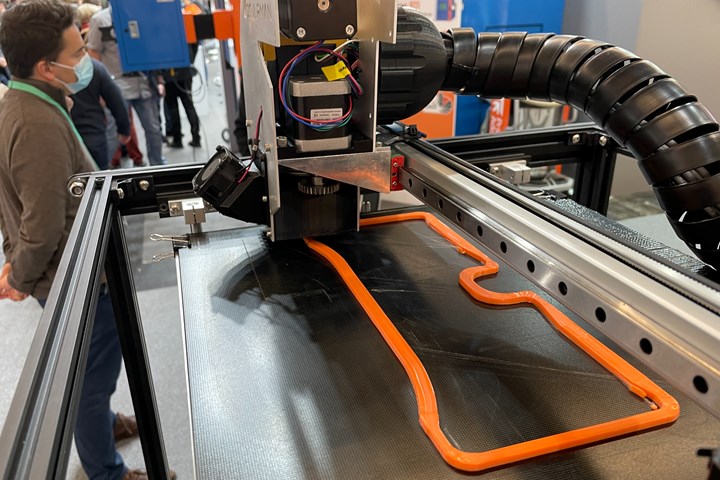
An FFF build employing real-time control over the variable layer width. The nozzle here can vary from 0 to 10 mm in deposition width.
The cross section of the nozzle opening that deposits material in fused filament fabrication (FFF) 3D printing is, in almost all cases, a circle. Faster deposition entails extruding through a bigger circle. Is this the ideal shape?

View of the variable-width opening. This photo shows the nozzle still under development that is capable of varying from 0 to 20 mm in layer width.
Sculpman, a startup founded in Belgium, is pioneering FFF through a rectangular nozzle orifice. The advance this makes possible is taking control of the width of the rectangle and varying this as needed throughout the build. That means layer width becomes a controllable variable just like layer height. Late last year at the Formnext expo, the company demonstrated filament-fed 3D printing with a nozzle orifice width continuously variable from 0 to 10 mm. (See video below.) Larger nozzles are under development, including a pellet-fed version variable from 0 to 20 mm in layer width, offering layer height up to 4 mm.
The benefit this promises is faster FFF build speed without loss to quality. Disconnecting layer width from layer height in this way allows for fast 3D printing and fine 3D printing in the same build. Wide ribbons of material can be deposited rapidly to build thick walls or solid sections, and then the nozzle orifice can narrow to print thin walls or small features.

Because the layer is a rectangular "ribbon," nozzle direction becomes important. Controlled orientation of the nozzle keeps the ribbon aimed along the print path. Photo: Sculpman.
“Ribbon” is an image Sculpman uses to describe the form of its material deposition, contrasting this with the “spaghetti” shape of conventional FFF. Printing in a ribbon form presents the new challenges the system has been developed to overcome. For example, the Sculpman nozzle features controlled rotation around its centerline, because the ribbon of deposition must be kept always aimed in the direction of the print path. (Spaghetti does not present this problem.) More significantly, the extruder’s volumetric rate has to vary in coordination with the nozzle, changing volume so that the layer height stays fixed as the orifice width changes. Because of these additional axes needing control, software development has been at least as important as the hardware. Slicer software from Sculpman is part of the system, enabling deposition with this more complex set of motions.

The threaded exterior is coupled to an inner cylindrical form in which diameter is constant. Controlled variation of the layer width speeds the build time of a form such as this. This part measuring about 155 mm long and 130 mm wide was printed in 2.25 hours using the variable nozzle, where printing it with a fixed nozzle size small enough for the thinnest regions would have taken more than 10 times as long. Photo: Sculpman.
Related Content
-
Video: 3D Printed Hand Tools in Action on Pella Corporation Factory Tour
Examples include an invention for quickly installing window and door weather stripping, a fitting for giving the proper angle to a nail gun, and a clip for which the color is an important feature.
-
3D Printing Brings Sustainability, Accessibility to Glass Manufacturing
Australian startup Maple Glass Printing has developed a process for extruding glass into artwork, lab implements and architectural elements. Along the way, the company has also found more efficient ways of recycling this material.
-
Stratasys F3300 FDM 3D Printer Boosts Productivity, Print Reliability, Part Yield
The F3300 FDM 3D printer is built for performance-oriented manufacturers, expanding the range of production capabilities with improved accuracy, uptime and twice the output.













